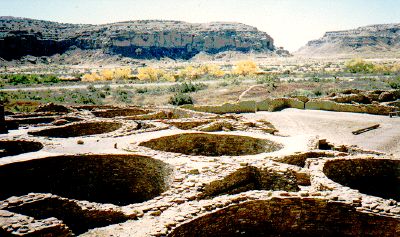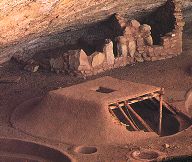
Nine of the 37 kivas
found in Pueblo Bonito.
Kiva means 'world below'. Small kivas such as these
may have been a suite of domestic rooms.
KIVAS
The kiva is always the center of the mandala. It is the secret, hidden place where the sipapu meets the sky, the safe place where the past meets the future. The kiva is a place of refuge, a sanctuary from the unpredictability of the elements, a private and safe space combining the practical and spiritual dimensions of existence in one form, a womb of culture and vision, a special opening into the reality of mother. Smaller kivas may have been used like living rooms, the focal point for local clans, a place to stay warm on a winter's day or to keep cool during the summer months while relaxing. The larger kivas provided a place to smoke and discuss community business. At certain times of year, they were used as holy places, accomodating many people visiting from outside the canyon. At these times, there would be chanting, recounting of oral histories, relevant stories and teachings in preparation for rituals. The circle around a central fire pit is a natural mandala, tending to bring the participants into visual contact and intimate communication. The kiva is an architectural form designed to host the spirit of council fires and gatherings of all kinds which had once taken place outdoors or in caves and natural rockhouses.

Nine of the 37 kivas
found in Pueblo Bonito.
Kiva means 'world below'. Small kivas such as these
may have been a suite of domestic rooms.
The Anasazi who settled in Chaco around 550 AD, lived on the mesas above the canyon in simple dwellings called pit houses. A shallow depression would be dug out of the earth, the edge lined with flat stones leaning outward. Four posts arranged in a square were inserted into the floor of the pit. Four horizontal beams were lashed to these, defining the roof of the structure.
 Log
sections were added to span the distance from the beams to the earth and
covered in poles, sticks and mud. A basin in the floor served as a fire
pit, used for cooking and heating. Since most of the structure was above
ground, there may have been many variations in size and shape which are
no longer apparent. Soon the Anasazi were building arcs of multi-room additions
around their pit houses. Later, it became fashiohable to move into the
outer storage rooms. The pit gradually became identified with the past
and the ancestors, a return to traditional ways. By the middle of the eighth
century , pit houses were no longer used for storage but occupied the center
of pueblos throughout the southwest; by the millenium, the pit house
is designed on a bigger scale and surrounded by multi-storied dwellings.
(Mesa Verde pit house photo courtesy of Time Life Books,The Mound
Builders & Cliff Dwellers, 1992)
Log
sections were added to span the distance from the beams to the earth and
covered in poles, sticks and mud. A basin in the floor served as a fire
pit, used for cooking and heating. Since most of the structure was above
ground, there may have been many variations in size and shape which are
no longer apparent. Soon the Anasazi were building arcs of multi-room additions
around their pit houses. Later, it became fashiohable to move into the
outer storage rooms. The pit gradually became identified with the past
and the ancestors, a return to traditional ways. By the middle of the eighth
century , pit houses were no longer used for storage but occupied the center
of pueblos throughout the southwest; by the millenium, the pit house
is designed on a bigger scale and surrounded by multi-storied dwellings.
(Mesa Verde pit house photo courtesy of Time Life Books,The Mound
Builders & Cliff Dwellers, 1992)

The floor of the Great Kiva in Chetro Ketl
Two of the four masonry-lined pits used for roof support posts; when they were excavated, one of the pits still held a post 26 1/2 " thick, as well as offerings of turquoise chips in leather bags. The large sandstone disk was used as a footing for the post. The square structure is a firebox.
Niches in the outer walls held strings of stone and shell
beads and were then sealed with masonry.
turtle hill ©2000